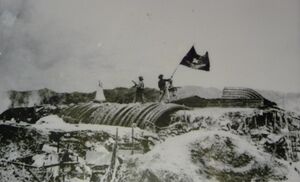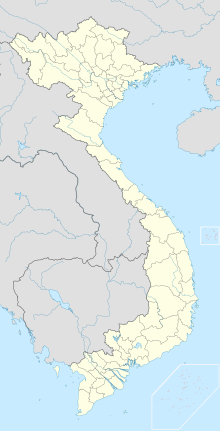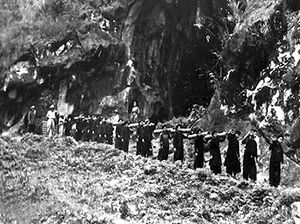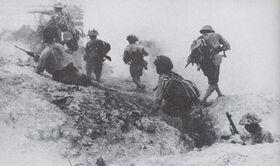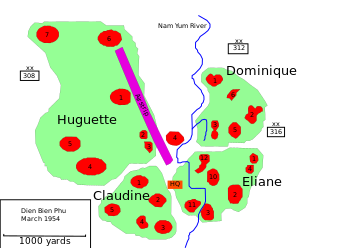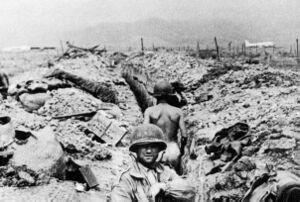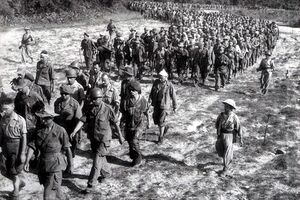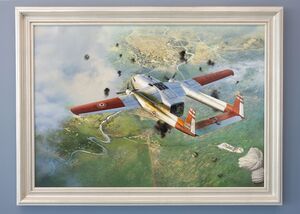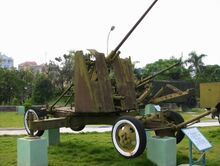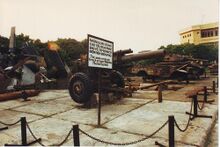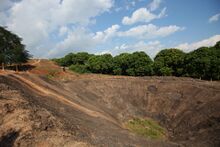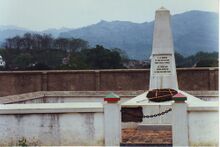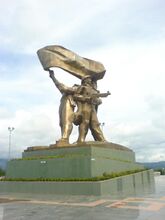معركة ديان بيان فو
معركة ديان بيان فو (فرنسية: Bataille de Diên Biên Phu; ڤيتنامية: Chiến dịch Điện Biên Phủ)، هي أول مواجهات الحرب الهندية الصينية بين فيلق القوات الفرنسية في الشرق الأقصى التابع للاتحاد الفرنسي وجبهة الثوار الشيوعيين ڤييت مينه. وقعت أحداث المعركة بين مارس ومايو 1954، بلغت أوجها إثر هزيمة الفرنسيين ثم إنعقدا مفاوضات في جنيڤ لتحديد مستقبل الهند الصينية. The French began an operation to insert, then support, their soldiers at Điện Biên Phủ, deep in the hills of northwestern Vietnam. The operation's purpose was to cut off Viet Minh supply lines into the neighboring Kingdom of Laos (a French ally), and draw the Viet Minh into a major confrontation in order to cripple them. The plan was to resupply the French position by air - based on the belief that the Viet Minh had no anti-aircraft capability. The Viet Minh, however, under General Võ Nguyên Giáp, surrounded and besieged the French. They brought in vast amounts of heavy artillery (including anti-aircraft guns) and managed to move these bulky weapons through difficult terrain up the rear slopes of the mountains. The Viet Minh then dug tunnels through the mountain and emplaced the artillery pieces overlooking the French encampment. In March, a massive artillery bombardment by the Viet Minh ensued. The strategic positioning of their artillery made it nearly impervious to French counter-battery fire. Tenacious fighting on the ground ensued, reminiscent of the trench warfare of World War I. At times, the French repulsed Viet Minh assaults on their positions while supplies and reinforcements were delivered by air. As key positions were overrun, the perimeter contracted, and the air resupply on which the French had placed their hopes became impossible. As the Viet Minh anti-aircraft fire took its toll, fewer and fewer of those supplies reached the French. The garrison was overrun in May after a two-month siege, and most of the French forces surrendered. A few of them escaped to Laos. The French government in Paris then resigned, and the new Prime Minister, the left-of-centre Pierre Mendès France, supported French withdrawal from Indochina. The Battle of Điện Biên Phủ was decisive; the war ended shortly afterward and the 1954 Geneva Accords were signed. France agreed to withdraw its forces from all its colonies in French Indochina, while stipulating that Vietnam would be temporarily divided at the 17th parallel, with control of the north given to the Viet Minh as the Democratic Republic of Vietnam under Ho Chi Minh, and the south becoming the State of Vietnam, nominally under Emperor Bảo Đại, preventing Ho Chi Minh from gaining control of the entire country.[16] خلفية تاريخية وتجهيزات المعركةفي نوفمبر 1953، كانت حرب الهند الصينية الأولى تسير باتجاه سيء لفرنسا، التي بدأت في بناء قاعدة للجيش حول قرية ديان بيان فو التي تُسمى أيضاً ديان بيان، فيما يعرف الآن بشمال غربي ڤيتنام، وكان الغرض من هذه القاعدة هو تعطيل حركة الجيش الڤتنامي. وفي 13 مارس عام 1954م، شنَّ حوالي 50,000 جندي ڤتنامي هجومًا على قوات فرنسية يزيد قوامها على 10,000 حندي في القاعدة، ودمروا سريعًا مطار القاعدة تاركين الفرنسيين بدون مؤن كافية. وقاوم الفرنسيون، على الرغم من قلة عددهم، الهجوم الفيتنامي لمدة 56 يومًا، ولكنهم أُجبروا على الاستسلام في 7 مايو 1954، وانتهى القتال في أوائل اليوم التالي. [17]. وتردد علي ألسنة الخبراء العسكريين أن الجانب الفرنسي أراد استدراج القوات الفيتنامية الي تلك المنطقة التي اقام فيها الفرنسيون حامية ضخمة تعتبر الاهم في المنطقة من حيث الحجم والتسليح الحديث فحشد الجنرال الفيتنامي نجوين جياب قوات متفوقة في العدد وفي الروح المعنوية حول التلال المحيطة بالمنطقة واستعان بعنصر الطبيعة المحيطة من اشجار كثيفة ومناطق وعرة في اخفاء قواته وسلاحه وهو ما ادي الي تضليل الغارات الجوية الفرنسية ، وعندما بدأت المعركة وجدت القوات الفرنسية نفسها محاصرة. ومع تعذر الحصول علي امدادات عن طريق البر لجأت فرنسا إلي الجو وحيث اصبح انزال مظليين عن طريق الجو هو الاسلوب الوحيد لنقل الامدادات. وعندها خرجت المدافع المضادة للطائرات من مخابئها لتحصد الطائرات والمظليين وتضيق الخناق علي القوات الفرنسية. واتسم التكتيك الفيتنامي بالتحول من قتال سريع لتحقيق نصر سريع الي قتال بثبات لتحقيق تقدم ثابت. نا سان ومفهوم القنفذ
تمهيدالمقدمة لعملية القندس
التخطيط للعملية الجوية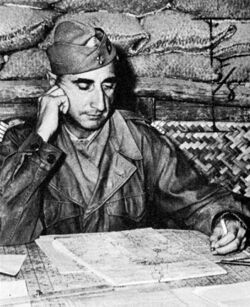 الكولونيل كريستيان دى كاستري، قائد القوات الفرنسية في ديان بيان فو.
تغيير استراتجيةي گياپالمعركةبياتريس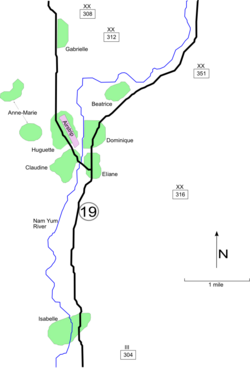 French dispositions at Điện Biên Phủ, as of March 1954. The French took up positions on a series of fortified hills. The southernmost, Isabelle, was isolated. The Viet Minh positioned their five divisions (the 304th, 308th, 312th, 316th, and 351st) in the surrounding areas to the north and east. From these areas, the Viet Minh artillery had a clear line of sight to the French fortifications and were able to accurately target the French positions.
گابرييل
آن ماريلول
اشتباكات 30 مارس – 5 أبريل
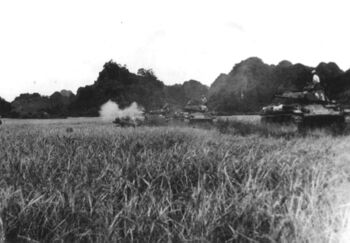 The French deployed a small number of M24 Chaffee light tanks (US supplied) during the battle which they nicknamed "Bisons". The Viet Minh countered these with heavy artillery and rocket-propelled grenade launchers (RPGs).
حرب الخنادق, which was caught on open ground. At that point, Giáp decided to change tactics. Although Giáp still had the same objective – to overrun French defenses east of the river – he decided to employ entrenchment and sapping to achieve it.[18] On 10 April, the French attempted to retake Eliane 1, which had been lost eleven days earlier. The loss posed a significant threat to Eliane 4, and the French wanted to eliminate that threat. The dawn attack, which Bigeard devised, began with a short, massive artillery barrage, followed by small unit infiltration attacks, then mopping-up operations. Eliane 1 changed hands several times that day, but by the next morning the French had control of the strong point. The Viet Minh attempted to retake it on the evening of 12 April, but were pushed back.[19] At this point, the morale of the Viet Minh soldiers was greatly lowered due to the massive casualties they had received from heavy French gunfire. During a period of stalemate from 15 April to 1 May, the French intercepted enemy radio messages which told of whole units refusing orders to attack, and Viet Minh prisoners in French hands said that they were told to advance or be shot by the officers and non-commissioned officers behind them,[20] much like Stalin's "Not A Step Back!" decree of WWII, under which troops were compelled to advance even in the face of withering enemy fire, and were strictly forbidden to retreat. Worse still, the Viet Minh lacked advanced medical treatment and care, with one captured fighter stating that, "Nothing strikes at combat-morale like the knowledge that if wounded, the soldier will go uncared for".[21] Concerned about a potential mutiny from his troops, Giáp had to call for fresh reinforcements from neighbouring Laos to bolster his dwindling and dispirited forces. During the fighting at Eliane 1, on the other side of camp, the Viet Minh entrenchments had almost entirely surrounded Huguette 1 and 6. On 11 April the garrison of Huguette 1, supported by artillery from Claudine, launched an attack with the goal of resupplying Huguette 6 with water and ammunition. The attacks were repeated on the nights of the 14–15 and 16–17 April. While they did succeed in getting some supplies through, the French suffered heavy casualties, which convinced Langlais to abandon Huguette 6. Following a failed attempt to link up, on 18 April, the defenders at Huguette 6 made a daring break out, but only a few managed to make it to French lines.[22][23] The Viet Minh repeated the isolation and probing attacks against Huguette 1, and overran the fort on the morning of 22 April. After this key advance, the Viet Minh took control of more than 90 percent of the airfield, making accurate French parachute drops impossible.[24] This caused the landing zone to become perilously small, and effectively choked off much needed supplies.[25] A French attack against Huguette 1 later that day was repulsed.[26] ---> إيزابلالهجمات الأخيرةالنساءالتبعاتالأسرى
الخسائرمشاركة الولايات المتحدة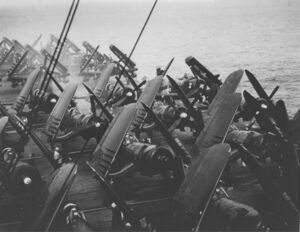 Unmarked Vought AU-1 Corsair fighters on the deck of the U.S. Navy light aircraft carrier USS Saipan (CVL-48) in the South China Sea, in 1954. The Corsairs were drawn from Marine Attack Squadron VMA-324 and flown from the Saipan to Da Nang and delivered to the French navy.
أرض المعركة
في الثقافة العامةمقارنة بمعركة خى سانهالأثر العالميوتعتبر معركة ديان بيان فو التي وقعت عام1954 من اهم المعارك العسكرية في القرن الـ20 نتيجة لما ادت اليه من نتائج سياسية انعكست آثارها علي ساحة العلاقات الدولية واستمر تأثيرها حتي اليوم وهي في ذلك تتشابه مع ما ادت اليه حرب السويس في مصر عام1956 من نتائج خاصة وان الطرف الفرنسي كان طرف رئيسيا مشترك في الازمتين كما انه كان الطرف الخاسر في الواقعتين اللتين مثلتا بداية النهاية للامبراطورية الاستعمارية الفرنسية في صورتها الكلاسيكية القديمة ليس في اسيا وحدها بل في العالم اجمع كما كانت تلك المعركة والعدوان الثلاث على مصر نموذجين سارت علي هديهما الكثير من الدول التي كانت خاضعة للاستعمار. وقد جاءت معركة ديان بيان فو لتؤكد أن صفحة الاستعمار القديم في طريقها لأن تطوي في ظل وجود قوي جديدة وتحول العالم الي القطبية الثنائية تحت قيادة الولايات المتحدة والاتحاد السوفيتي وربما كان هذا ما فسر موقف الولايات المتحدة من أزمة السويس 1956 وعدم تأييدها لفرنسا وبريطانيا في مسعاهما ، كما فسر ايضا تخلي القوات الامريكية عن فرنسا في فيتنام ثم تدخلها في المنطقة عسكريا وسياسيا في عام 1964! وكان من النتائج المباشرة لتلك المعركة ان انهت فرنسا استعمارها لفيتنام ولمنطقة الهند الصينية باسرها بعد وجود عسكري بدأ منذ عام1858. كما حصلت فيتنام علي تأكيد لاستقلالها عن فرنسا بعد حرب استمرت منذ عام 1945 وحتي عام 1954 عندما وقعت فرنسا علي اتفاقيات جنيف المتعلقة بفيتنام لعام 1954 والتي اعترفت باستقلال وسيادة ووحدة اراضي فيتنام وفي الاول من يناير 1955 تم نقل السلطة الي الحكومات الوطنية في كل من فيتنام ولاوس وكامبوديا ايذانا بانتهاء اتحاد الهند الصينية الذي شكلته فرنسا لحكم المنطقة في عام1887. ومن المفارقات ان عاد خروج فرنسا من فيتنام ليس بالفائدة علي فيتنام وحدها بل علي فرنسا ذاتها وهو الامر الذي فسره البروفيسور روبرت فرانك من جامعة السربون بأن هزيمة القوات الفرنسية في ديان بيان فو وفرت لاقتصادها فرصة الازدهار في عالم ما بعد الاستعمار حيث اصبح يحتل المرتبة الرابعة عالميا. اتفاق جنيفوفي يوليو 1954 تم التوقيع على اتفاق جنيف الذي ينهي الحرب بين فرنسا وفيتنام بحضور وفدي فيتنام ووفود فرنسا وبريطانيا والاتحاد السوفياتي والصين الشعبية والولايات المتحدة ولاوس وكمبوديا. وكان من نتائج الاتفاق تقسيم فيتنام إلى شطرين يفصل بينهما خط العرض 17. ورغم حضورهما في جنيف فإن الولايات المتحدة وحكومة سايغون الموالية لها لم توقعا على الاتفاق. وفور رحيل فرنسا من فيتنام بدأت الولايات المتحدة تساعد حكومة سايغون عسكريا. في 24 أكتوبر 1954 منح الرئيس الأميركي أيزنهاور مساعدة مالية سخية لحكومة سايگون ظلت قيمتها في ازدياد مع الزمن، كما بدأ المستشارون العسكريون الأميركيون يتوافدون على فيتنام الجنوبية بدءا من فبراير 1955 من أجل تدريب الجنود هناك. وفي 23 أكتوبر 1955 ظهرت أول حكومة في فيتنام الجنوبية منتخبة بقيادة "نغو دينه ديم"، وكان أول قرار اتخذته حكومته هو الامتناع عن أي استفتاء من شأنه أن يؤدي إلى اتحاد الشطرين الفيتناميين، مبررة ذلك بعدم حرية السكان في الجزء الشمالي. [27]. عالم جديدوفي عالم ما بعد ديان بيان فو صمتت المدافع وتحول العدو القديم الي مستثمر اليوم والغد.. وشهد شهر مارس الماضي تنظيم معرض في ديان بيان فو للتجارة والسياحة في محاولة لاجتذاب الاستثمارات الخارجية والتعاون في مجال الاعمال وتسويق منتجات المنطقة.وقد بدأ الفيتناميون حربهم ضد الفقر وخاصة في ديان بيان فو من خلال مشروعات انتاجية خفضت الفقر بالمنطقة بمقدار6.8% ولم يكن هذا التغيير الكبير الذي طرأ علي منطقة ديان بيان فو بمعزل عن التحولات المحلية والعالمية ففيتنام بدات برنامج التحديث( الدوي موي)في عام1986 وتمكنت من خفض معدل التضخم من500% الي6% في بداية التسعينيات وذلك في ظل معدل نمو اقتصادي قدر بـ8% في منتصف التسعينيات وان كان قد تراجع قليلا خلال السنوات التالية. وتسعي الخطط الحالية لتوفير فرص عمل لـ1.5 مليون شخص سنويا بحلول عام 2005 وتحقيق معدل نمو اقتصادي يقدر بـ7.5% سنويا. ولم يكن هذا التحول بالامر الغريب في ظل انفتاح فيتنام علي العالم وعودة العلاقات الفرنسية الفيتنامية عام 1973 وقيام الرئيسين الفرنسيين فرنسوا ميتران وجاك شيراك بزيارة فيتنام في عامي 1993 و1997 وقيام الرئيس الفيتنامي بزيارة فرنسا عام2002. وقد وقف الرئيس شيراك ليعلن أمام الرئيس الفيتنامي أن العولمة تفرض في كل مكان تحديث للمجتمع والمؤسسات.
مرئيات
الهوامش
المصادر
وصلات خارجية
وصلات ميديا
|
||||||||||||||||||||||||||||||||
- CS1 الفيتنامية-language sources (vi)
- مقالات مميزة
- Pages using gadget WikiMiniAtlas
- Articles containing فرنسية-language text
- Pages using Lang-xx templates
- Articles containing ڤيتنامية-language text
- Articles with hatnote templates targeting a nonexistent page
- CS1 errors: unsupported parameter
- Articles with dead external links from March 2009
- 1954 في فرنسا
- 1954 في فيتنام
- معارك وعمليات الحرب الهندية الصينية الأولى
- معارك فرنسا
- معارك فيتنام
- نزاعات 1954
- مقاطعة ديان بيان
- حركة الاستقلال الفتنامية
- أحداث مارس 1954
- أحداث أبريل 1954
- أحداث مايو 1954
- ڤو وين گياپ
